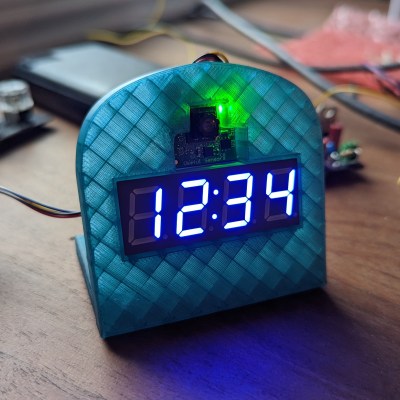We have a soft spot for devices that subvert purpose and expectation, and that definitely sums up [Guy Dupont]’s Clock That Is Wrong. It knows the correct time, but whether or not it displays the correct time is another story. That’s because nestled just above the 7-segment display is a person sensor module, and when it detects that a person is looking towards it, the clock will display an incorrect time, therefore self-defeating both the purpose and primary use case of a clock in one stroke.
 The person sensor is a tiny board with tiny camera that constantly does its best to determine whether a person is in view, and whether they are looking towards the sensor. It’s a good fit for a project like this, and it means that one can look at the clock from an oblique angle (meaning one is out of view of the sensor) and see the correct time. But once one moves in front of it, the time changes. You can watch a brief video of it in action in this Twitter thread.
The person sensor is a tiny board with tiny camera that constantly does its best to determine whether a person is in view, and whether they are looking towards the sensor. It’s a good fit for a project like this, and it means that one can look at the clock from an oblique angle (meaning one is out of view of the sensor) and see the correct time. But once one moves in front of it, the time changes. You can watch a brief video of it in action in this Twitter thread.
One interesting bit is that [Guy] uses an ESP32-based board to drive everything, but had some reservations about making a clock without an RTC. However, he found that simply syncing time over the network every 10 minutes or so using the board’s built-in WiFi was perfectly serviceable, at least for a device like this.
This reminds us a little of other clocks with subtly subversive elements, like the Vetinari Clock which keeps overall accurate time despite irregularly drifting in and out of sync. Intrigued by such ideas? You’re not alone, because there are even DIY hobby options for non-standard clock movements. Adding the ability to detect when someone is looking directly at such a device opens up possibilities, so keep it in mind if it’s time for a weekend project.
















Granted nothing is completely secure, for those who are not a great fan of cloud based facial recognition, this device, locally processing the data and just giving out what’s required, seems like a nice step in the right direction. Not to mention making interfacing a bit more straight forward. On it’s own, this could be great for small projects, but paired with other systems, little self contained modules like this could make for some interesting things coming down the road.
A lot of devices seem to use facial recognition these days, it would be nice to be able to take the big brother aspect out of the equation.
This is SO totally cool. And the person sensor is currently only about $10. I love it!
Wasting time, by making the very time itself meaningless, pointless, and untrustworthy
> …had some reservations about making a clock without an RTC
I mean, how important is accurate timing, when it’s just going to lie to you anyway?
Very important, if the timing is wrong, it could tell you the correct time.
If you know for a fact the displayed time is incorrect, that’s at least one time you are assured it isn’t, thereby making this clock marginally useful. Through enough trial and error and studious observation one might be able to tell what time it actually is by figuring out what time it refuses to display.
If it shows you a consistently wrong time (say, +5h 26m), then it will be impossible to figure out.
If it shows you a different offset each day, you would need to observe it for around a year in order to deduce the time. More if the time can be anything *but* the exact, correct time in minutes.
Just a minor nit pick to an otherwise funnily smart hack, instead of displaying incorrect time when someone looks at it, it should just display “NOPE” on the display.
Or impossible times, like 25:71
hey, that’s just a rollover problem. that’s 02:11 …
Just the blinking 12:00 will do…
I don’t want to brag, but for plenty of years now, I have in my kitchen a clock that always display the incorrect time, whether someone is looking at it or not.
Provided that a broken clock gives the right time twice a day, having one that *always* gives you the wrong time is also quite an achievement.
Well, suppose you make a 25 hour clock that runs in 24 hour time.
A broken clock, yes. My kitchen clock is functional but wrong. Checkmate, correctists.
But it only displays the wrong time when you’re looking at it so how do you KNOW?
That is so stupid. I want it.
so many terrible ideas to have fun.
like just showing the wrong time, when a specific face is detected.
or just showing the wrong time, when exactly one face is detected. no witness for you!
or both together. driving someone crazy.
iS IT ON AMAZON YET?!
Looking over the “person sensor”, I see another possibility. The sensor can detect more than one person. So another option is to kind of invert it by only displaying the correct time when two or more people are looking at it.